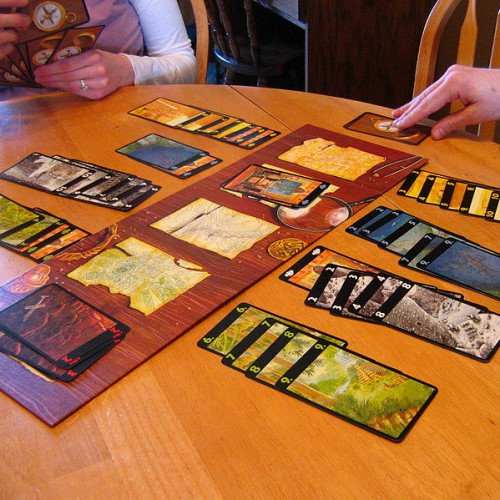COMMANDS & COLORS: ANCIENTS VS LOST CITIES

COMMANDS & COLORS: ANCIENTS
Commands & Colors: Ancients is a board wargame designed by Richard Borg, Pat Kurivial, and Roy Grider, and published by GMT Games in 2006. It is based on Borg's Commands & Colors system using some elements similar to his other games such as Commands & Colours: Napoleonics, The Great War, Memoir '44 and Battle Cry designed to simulate the "fog of war" and uncertainty encountered on real battlefields. Commands & Colors: Ancients focuses on the historic period of 3000 BC - 400 AD. The core game includes several hundred wood blocks in two colors for the Roman/Syracusan armies and Carthaginian army. Sheets of stickers representing different unit types must be affixed to the blocks prior to initial play. 16 small wooden blocks representing "victory banners" and 7 larger plastic dice must also have stickers applied. Extra stickers are included for use as replacements. The game also contains a full-color rule book, color scenario book, and two color two-page double-sided "cheat sheets" for players to reference during play for dice results and unit statistics. The board is folded card stock laid flat for play. Hexagonal terrain pieces are laid on the board when called for by a scenario. A deck of command cards is included. Units are arranged on the board according to maps and scenario descriptions in the scenario book. Players are dealt a number of command cards equal to their "command value" for the chosen scenario. Often players have different command values and therefore different numbers of cards. Players take turns playing their cards to "order" units, generally allowing the ordered units to move and conduct combat. Cards often refer to a section of the battlefield, either left, center, or right, or some combination of these. There are also many special cards that allow very specific actions. Play continues until one player earns the requisite number of victory banners for the scenario. Victory banners are earned each time a player completely eliminates an enemy unit or leader.
Statistics for this Xoptio

LOST CITIES
Lost Cities is a 60-card card game, designed in 1999 by game designer Reiner Knizia and published by several publishers. The objective of the game is to mount profitable expeditions to one or more of the five lost cities (the Himalayas, the Brazilian Rain Forest, the Desert Sands, the Ancient Volcanos and Neptune's Realm). The game was originally intended as a 2-player game, but rule variants have been contributed by fans to allow 1 or 2 further players, causing Reiner Knizia himself to later provide semi-official 4-player rules. Lost Cities is a fast-moving game, with players playing or discarding, and then replacing, a single card each turn. Cards represent progress on one of the five color-coded expeditions. Players must decide, during the course of the game, how many of these expeditions to actually embark upon. Card-play rules are quite straightforward, but because players can only move forward on an expedition (by playing cards which are higher-numbered than those already played), making the right choice in a given game situation can be quite difficult. An expedition that has been started will earn points according to how much progress has been made when the game ends, and after three rounds, the player with the highest total score wins the game. Each expedition that is started but not thoroughly charted incurs a negative point penalty (investment costs). Interaction between players is indirect, in that one cannot directly impact another player's expeditions. However, since players can draw from the common discard piles, they are free to make use of opposing discards. Additionally, since the available cards for a given expedition are finite, progress made by an opponent in a given color can lead to difficulty making progress in that same color. The game's board, while designed to supplement the theme, is optional and consists only of simple marked areas where players place discards. If Lost Cities had four expeditions instead of five, it could be played with a standard deck of playing cards. When doing so, the face cards would represent investment cards, with numbered cards two through ten serving as the expedition progress cards.